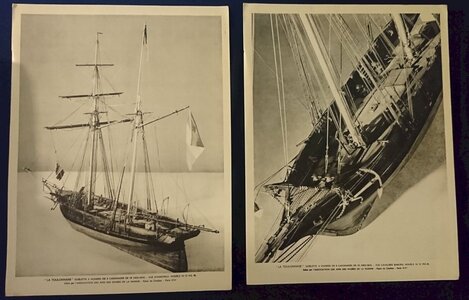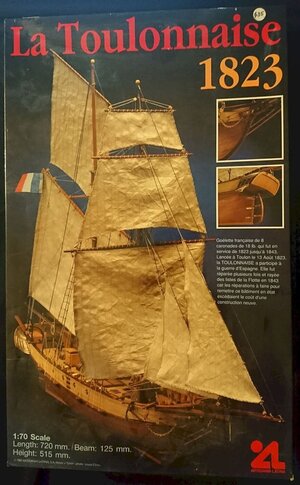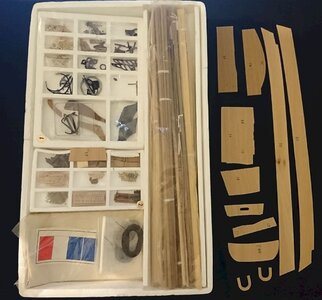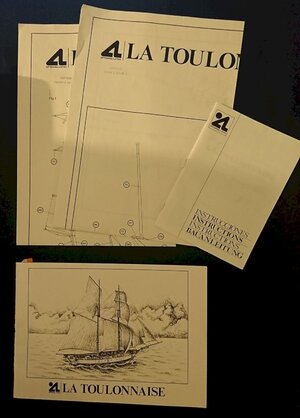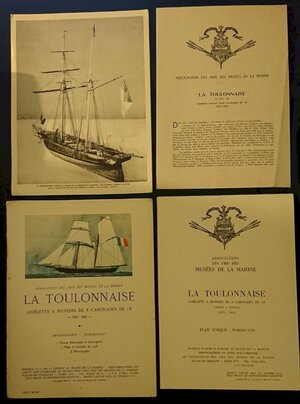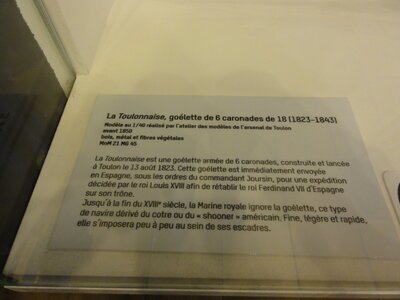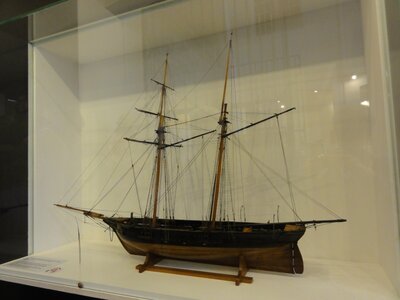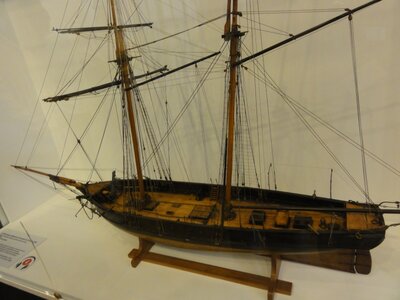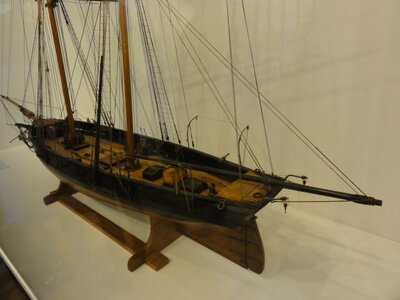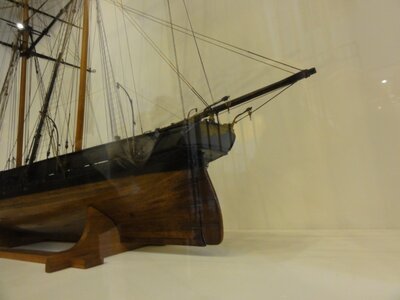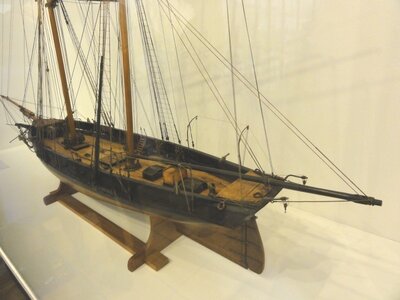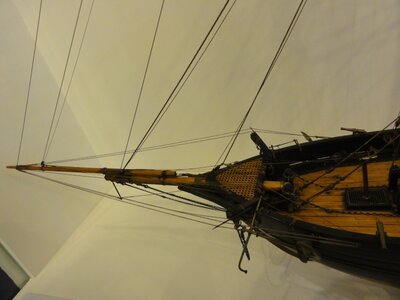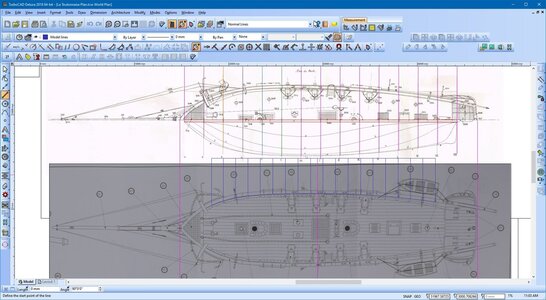You are using an out of date browser. It may not display this or other websites correctly.
You should upgrade or use an alternative browser.
You should upgrade or use an alternative browser.
La Toulonnaise 1823 - French schooner Artesania Latina 1:70 by Jeff W
- Joined
- Mar 17, 2019
- Messages
- 87
- Points
- 113

La Toulonnaise - Schooner (1823-1843)
This schooner is a two-mast vessel with jibs and fore and aft sails. The foremast may have a topsail and a topgallant, which is the case of the Museum model.
This very elegant small vessel was launched in Toulon in August 1823. She saw action particularly in Spain and sailed until 1843, at which time she was decommissioned.
This model has very simple lines and no flashy colours; ornamentation is simplified. Iron appears: stretching devices, davits, port lids hinges. She carries 8 caron guns. The anchor cables are now iron chains.
CHARACTERISTICS:
• Length: 31.50 meters (49.90 meters overall)
• Width: 7.30 meters
• Draft: 2.77 meters
• Height: 34.87 meters (mainstem keel)
• Sail: 680 m2
• Displacement : 90 tons (250 t)
• Armament: 8 carronades of 18 pounds and 4 scallops. (6 carronades at launch, 2 will be added later, probably in 1832)
• crew: 61 (EM included)
• 18 tons of food shipped for 61 men and a 3-month campaign:
This schooner is a two-mast vessel with jibs and fore and aft sails. The foremast may have a topsail and a topgallant, which is the case of the Museum model.
This very elegant small vessel was launched in Toulon in August 1823. She saw action particularly in Spain and sailed until 1843, at which time she was decommissioned.
This model has very simple lines and no flashy colours; ornamentation is simplified. Iron appears: stretching devices, davits, port lids hinges. She carries 8 caron guns. The anchor cables are now iron chains.
CHARACTERISTICS:
• Length: 31.50 meters (49.90 meters overall)
• Width: 7.30 meters
• Draft: 2.77 meters
• Height: 34.87 meters (mainstem keel)
• Sail: 680 m2
• Displacement : 90 tons (250 t)
• Armament: 8 carronades of 18 pounds and 4 scallops. (6 carronades at launch, 2 will be added later, probably in 1832)
• crew: 61 (EM included)
• 18 tons of food shipped for 61 men and a 3-month campaign:
11 000 liters of water
2328 liters of wine
400 liters of brandy
500 kg of biscuits
1100 kg of cured meats (2/3 bacon and 1/3 beef)
1220 kg of flour
175 kg of salt
1125 kg of pulses (beans, beans, peas, rice...)
Last edited:
- Joined
- Mar 17, 2019
- Messages
- 87
- Points
- 113

HISTORY:
This schooner was built to take part in the Spanish expedition. Guardian of Barcelona, she participated in the cannoning of the port facilities of Cadiz, in August 1823, as can be seen below (in a photo of time):
She returned to Toulon December 2, 1823 and left on January 9, 1824 to contribute to the repression of the slave trade on the coasts of Africa.
She returned in August and sailed from Rochefort on August 21 for Spain to St Sebastian and Port du Passage before returning to Toulon, where she left on January 18, 1825 to participate in the operations of Algiers. She returned on February 13th.
She left on March 27 for Senegal and returned to Brest on August 10, 1826. She left on October 19 and her trips led her to Cayenne, Martinique, Newfoundland.
In 1832, when returned to Brest, the ship was subjected to a complete overhaul: substitution of part of the internal and external gunwales, the gutter fur and the plating of the bridge, as well as the total reconstruction of the superstructures of the bridge. His sails were considerably modified.
On March 31, 1834, she sailed for Newfoundland and anchored on May 5 in the harbor of St. Pierre and Miquelon.
On October 15, she returned to Brest where she left on November 25, 1834 for Cayenne.
She remained in the West Indies.
In 1836 it was the subject of a new campaign of repairs at Fort de France: the hull and the walls were fully restored.
She took the sea to cross durably in the waters of the Caribbean to fight against pirates.
Finally, she returned to Brest in 1843 where she was removed from the lists of the fleet on December 18 because the cost of repairs was estimated at more than 2/3 of a new construction.
Sources: SHOM (administrative public institution under the supervision of the Ministry of Défense), Colonial and Maritime Annals, and Bulletin of Laws.
This schooner was built to take part in the Spanish expedition. Guardian of Barcelona, she participated in the cannoning of the port facilities of Cadiz, in August 1823, as can be seen below (in a photo of time):
She returned to Toulon December 2, 1823 and left on January 9, 1824 to contribute to the repression of the slave trade on the coasts of Africa.
She returned in August and sailed from Rochefort on August 21 for Spain to St Sebastian and Port du Passage before returning to Toulon, where she left on January 18, 1825 to participate in the operations of Algiers. She returned on February 13th.
She left on March 27 for Senegal and returned to Brest on August 10, 1826. She left on October 19 and her trips led her to Cayenne, Martinique, Newfoundland.
In 1832, when returned to Brest, the ship was subjected to a complete overhaul: substitution of part of the internal and external gunwales, the gutter fur and the plating of the bridge, as well as the total reconstruction of the superstructures of the bridge. His sails were considerably modified.
On March 31, 1834, she sailed for Newfoundland and anchored on May 5 in the harbor of St. Pierre and Miquelon.
On October 15, she returned to Brest where she left on November 25, 1834 for Cayenne.
She remained in the West Indies.
In 1836 it was the subject of a new campaign of repairs at Fort de France: the hull and the walls were fully restored.
She took the sea to cross durably in the waters of the Caribbean to fight against pirates.
Finally, she returned to Brest in 1843 where she was removed from the lists of the fleet on December 18 because the cost of repairs was estimated at more than 2/3 of a new construction.
Sources: SHOM (administrative public institution under the supervision of the Ministry of Défense), Colonial and Maritime Annals, and Bulletin of Laws.
- Joined
- Mar 17, 2019
- Messages
- 87
- Points
- 113

- Joined
- Mar 17, 2019
- Messages
- 87
- Points
- 113

I was able to scan the plans using my A4 scanner and compiled them using a program from Microsoft, apparently not many people know about it, but it is excellent, and free.
Here is the link:
Image Composite Editor 2.0
The usual way of downloading it has been shutdown by Microsoft, but it is still available as you will see by a post at the link.
Here is the link:
Image Composite Editor 2.0
The usual way of downloading it has been shutdown by Microsoft, but it is still available as you will see by a post at the link.
- Joined
- Mar 17, 2019
- Messages
- 87
- Points
- 113

The resultant composition I was able to upload into TurboCad to reproduce accurate Stations for the production of the missing bulkheads. And to produce the false keel and deck and other missing parts. A lot of checking and adjustments had to be resolved. I found greater accuracy by compiling each view separately and importing each individually and aligning them to each other accordingly. This allowed adjustments in skew and scale and also minimize scanner lens anomalies. Best to adjust the image scale to full size ship dimensions for working on, then print to a chosen scale.
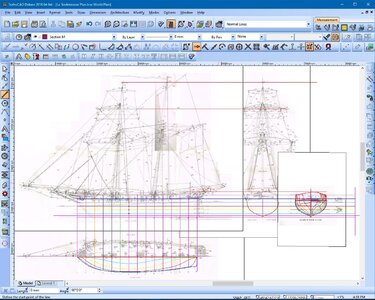

Actually you do not need « Build log » in fromt of the title ,there are several log starting like that but totally unnecessary as the thread is in one of the build log categoryHow does one change the Thread Title it should have been:
Build Log: French Schooner La Toulonnaise 1823 at 1:70
I modified the thread titleHow does one change the Thread Title it should have been:
Build Log: French Schooner La Toulonnaise 1823 at 1:70
- Joined
- Mar 17, 2019
- Messages
- 87
- Points
- 113

Thanks for that, I assume only admin can do this, and that we don't need "Build Log:" anymore?I modified the thread title
Never been necessary ,not sure why many members naming their thread/build log Build log,it should start with the Ship name ,ship type,manufacturer ,scale,here is an exemple:Thanks for that, I assume only admin can do this, and that we don't need "Build Log:" anymore?
La Toulonnaise 1823 - French schooner - Artesania Latina 1:70 by Jeff W
- Joined
- Mar 17, 2019
- Messages
- 87
- Points
- 113

Thankyou for that.Never been necessary ,not sure why many members naming their thread/build log Build log,it should start with the Ship name ,ship type,manufacturer ,scale,here is an exemple:
La Toulonnaise 1823 - French schooner - Artesania Latina 1:70 by Jeff W
- Joined
- Mar 17, 2019
- Messages
- 87
- Points
- 113

Spelling mistake, should be schoonerI modified the thread title
- Joined
- Mar 17, 2019
- Messages
- 87
- Points
- 113

There was a direction to do so some time ago, maybe a carry over from the previous site maybe? Anyway, I'll remember to format Thread Titles as you directed.Never been necessary ,not sure why many members naming their thread/build log Build log,it should start with the Ship name ,ship type,manufacturer ,scale,here is an exemple:
La Toulonnaise 1823 - French schooner - Artesania Latina 1:70 by Jeff W
Ship name - ship type - manufacturer and scale
- Joined
- Mar 17, 2019
- Messages
- 87
- Points
- 113

To have a look at some French ships see Uwek's post (includes the La Toulonnaise) follow this link:
Book Review: "MODELES HISTORIQUES au musée de la marine - Volume 2"
Book Review: "MODELES HISTORIQUES au musée de la marine - Volume 2"
Last edited:

